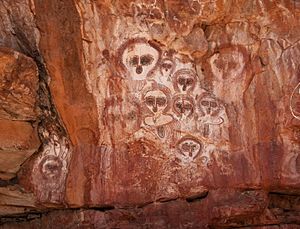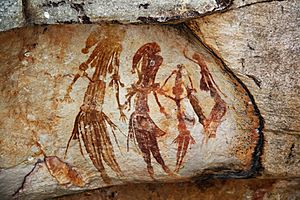Aboriginal art facts for kids

Aboriginal art is a special kind of art created by Indigenous Australian people. It's one of the oldest art traditions in the world, going back more than 30,000 years!
This art comes in many forms. Artists paint on leaves, carve wood and rock, sculpt, and even create designs on sand. They also make ceremonial clothing. Aboriginal art is deeply connected to spiritual beliefs and ceremonies. It's a key part of the world's longest-running cultural tradition, linked to totems and the Dreaming.
Aboriginal art uses many symbols to share stories and meanings. While some symbols have a common meaning, their meaning can change depending on the artwork or the Aboriginal group. This art is like a language, telling stories through amazing patterns.
Some Aboriginal artworks are very valuable. For example, in 2007, an artist named Yannima Pikarli Tommy Watson sold a painting for AU$240,000! In 2010, the Queensland Government decided to have two Tilt Trains painted by Indigenous artists Judy Watson and Alick Tipoti. These trains are 185 meters long, making them the biggest modern Aboriginal art piece.
Exploring Aboriginal Art Styles
There are many different ways Aboriginal people create art. These include painting on rocks and bark, making dot paintings, carving, sculpting, and weaving.
Rock Painting: Ancient Stories
Australian Indigenous rock art is the oldest continuous art tradition globally. The oldest rock painting found in Australia is a charcoal image. It was drawn 28,000 years ago in the Narwala Gabarnmang rock shelter in the Northern Territory. This makes it one of the oldest known rock art pieces on Earth.
Rock art includes both painting and engraving or carving. You can find it all over Australia. Some examples in Western Australia and South Australia might be 40,000 years old. Some paintings even show extinct animals like Genyornis and Thylacoleo. Other artworks show the arrival of European ships.
Rock Engravings: Carved Messages
Indigenous Australians used different methods to create rock engravings, depending on the type of rock. Famous sites include Murujuga in Western Australia, the Sydney rock engravings in New South Wales, and the Panaramitee rock art in Central Australia. The Sydney engravings show unique carved animals and humans.
The rock art at Murujuga is thought to be the world's largest collection of petroglyphs. It features images of animals like the thylacine, which are now extinct.
Dot Painting: A Modern Tradition
Dot painting uses small dots of paint. Common colors are yellow for the sun, brown for soil, red for desert sand, and white for clouds. These are traditional Aboriginal colors. Dot paintings can be made on many surfaces, like rocks or cave walls. They often show animals, landscapes, or stories from the Dreamtime.
Bark Painting: Art from Trees
Bark painting is done on sheets of bark from trees. These paintings are considered fine art. They can sell for high prices around the world. The best bark artists are recognized each year at the National Aboriginal & Torres Strait Islander Art Award.
Aerial Desert Landscapes: Maps of Stories
This art style looks like a map or a bird's-eye view of the desert landscape. It's often used to tell Dreaming stories. In the past, these designs were made on rock, sand, or as body painting. Today, they are often colorful drawings on canvas.
Stone Arrangements: Ancient Structures
Stone arrangements are found across Australia. Some are very large, like the 50-meter-wide circles in Victoria with 1-meter-high stones. Others are smaller, such as those near Yirrkala. These smaller arrangements show images of the praus used by Macassan Trepang fishermen and spear throwers.
Carvings and Sculptures: Three-Dimensional Art
- Carved shells – known as Riji
- Mimih (or Mimi) – small, human-like carvings of mythological impish creatures. Mimihs are said to be so delicate that they avoid windy days. Their necks are so thin a slight breeze might snap their heads off. If people approach them, they run into cracks in rocks, or the rocks open up to hide them.
- Fibre sculpture
Weaving and String Art: Useful and Beautiful
- Basket weaving
- Necklaces and other jewellery, like those made by the Tasmanian Aborigines
Symbols and Their Meanings
Modern Aboriginal art still uses traditional symbols. While the meaning of symbols can be similar across Australia, they can also change within one painting. A symbol like a circle might be used alone or in groups. Its meaning can depend on the artist's tribe. Circles could represent campfires, trees, hills, digging holes, water holes, or springs. The meaning can also change with the colors used, so water might be blue or black.
Many Aboriginal paintings tell a story from the Dreamtime. These stories often show how the land was created by ancestral beings. These paintings continue a tradition of songs, ceremonies, rock art, and body art that is thousands of years old.
To understand the symbols, it's important to look at the whole painting. Consider where the artist is from, the story behind the art, and the painting style. Colors can also give clues, like blue circles meaning water in some modern works.
Art, Culture, and Spirituality
Traditional Aboriginal art is almost always connected to the Dreamtime. Wenten Rubuntja, an Indigenous landscape artist, said that it's hard to find any art without spiritual meaning:
"Doesn't matter what sort of painting we do in this country, it still belongs to the people, all the people. This is worship, work, culture. It's all Dreaming. There are two ways of painting. Both ways are important, because that's culture." – The Weekend Australian Magazine, April 2002
Story-telling and showing totems are very important in all Aboriginal art. In some parts of Arnhem Land, artists use an X-ray style of painting, showing the inside of animals.
Protecting Ancient Art
Sadly, many important Aboriginal rock painting sites have been damaged over time. Early settlers and modern visitors have sometimes harmed them. Some sites were cleared or built over. Others have been damaged by people touching the paint or by graffiti. Many sites are now protected by fences or are closed to the public to keep them safe.
Images for kids
-
Picture of Albert Namatjira at the Albert Namatjira Gallery, Alice Springs Cultural Precinct, in 2007
-
Rainbow serpent by John Mawurndjul, 1991
-
Albert Namatjira refuelling for a trip to Alice Springs, around 1948
-
US President George W. Bush examines a Yirrkala Bark Painting at the Australian National Maritime Museum, 2007.
See also
 In Spanish: Arte aborigen australiano para niños
In Spanish: Arte aborigen australiano para niños










